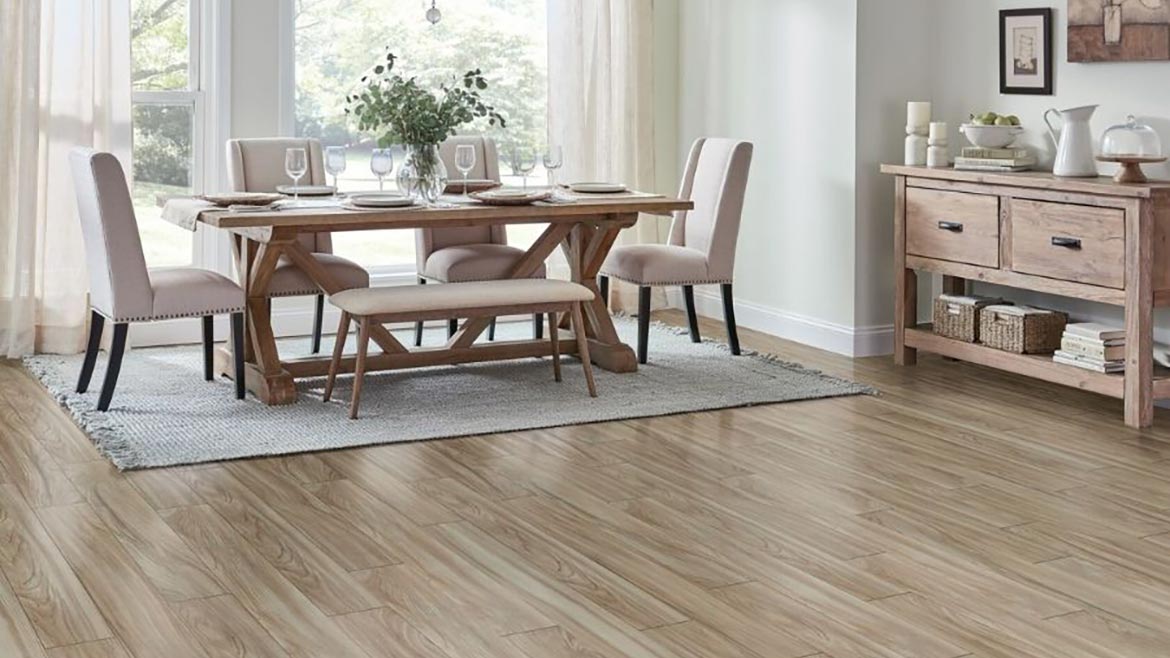Waterproof laminate flooring is an excellent option for areas prone to moisture, like kitchens, bathrooms, and utility rooms. Quick-Step has developed an innovative waterproof laminate with a ‘Hydroseal’ coating, making it resistant to water and moisture. This product is ideal if you're looking for an affordable and attractive waterproof floor covering. But what exactly is waterproof laminate flooring?
Waterproof laminate is a synthetic floor covering designed to mimic the look of real wood or stone tiles, though it is actually just a high-quality photograph of these materials. The planks are composed of several synthetic layers, including a fiberboard core, a high-quality photograph, and protective surface layers. High-quality waterproof laminate flooring is also scratch and scuff-resistant, making it highly durable.
The key difference between regular and waterproof laminate flooring lies in the additional ‘Hydroseal’ coating, which repels water and prevents damage. Quick-Step is known for its high-quality waterproof laminate products, offering durable and visually appealing flooring solutions.

Water has always been a challenge for traditional wood flooring, leading to swelling, rot, and mold. However, with 100% waterproof laminate flooring now available, these issues are no longer a concern. Below, we'll explain why innovative waterproof laminate flooring might be the right choice for your home.
Waterproof laminate flooring was originally created as a recycled wood floor covering made from scrap timber. Over time, it has evolved with high scratch-resistant surfaces and moisture-resistant fibers. Waterproof laminate flooring is made up of three main layers:
Waterproof laminate is classified as a "floating floor," meaning it doesn't require glue or nails during installation. Instead, the flooring uses a click-lock system that allows the planks to snap together like a puzzle.
When choosing laminate flooring, you have two main options: Engineered Wood and Plastic Waterproof Laminate.
Engineered wood flooring consists of multiple layers of materials pressed together. The core layers are made of fiberboard, plywood, or unfinished hardwood, with a top veneer layer of natural wood. This gives engineered wood the authentic appearance of hardwood, and it can be sanded and refinished multiple times.
Plastic waterproof laminate flooring is fully synthetic, with a moisture-resistant backing, a high-density fiberboard core, a design layer that simulates wood or stone, and a clear top layer for protection. Though it lacks the natural feel of hardwood, it is more durable and affordable, making it an ideal choice for homes with children and pets.
Several factors come into play when selecting waterproof laminate flooring, including location, thickness, plank size, and ease of installation.
Waterproof laminate planks are typically about 4 feet long and come in widths ranging from 3 to 7 inches. Narrower planks can help open up smaller rooms, while wider planks are better for larger spaces. However, wider planks can be more challenging to install due to their size.
Waterproof laminate is ideal for DIY installation because it uses a snap-and-lock system that doesn't require nails or glue. The flooring can be installed over existing floors (except for carpet), making it a convenient option for quick home upgrades. Just ensure that the subfloor is clean and smooth, and consider using underlayment for added sound absorption and moisture protection.
Waterproof laminate flooring is highly durable and scratch-resistant, making it perfect for high-traffic areas. Some products also include special locking designs that make them suitable for use in kitchens, bathrooms, and laundry rooms.
Waterproof laminate flooring offers a stylish, durable, and affordable alternative to traditional hardwood or stone floors. It’s easy to install, scratch-resistant, and available in various designs that mimic natural materials. With options for both residential and commercial use, waterproof laminate is an excellent choice for moisture-prone and high-traffic areas alike.

 Vietnam
Vietnam